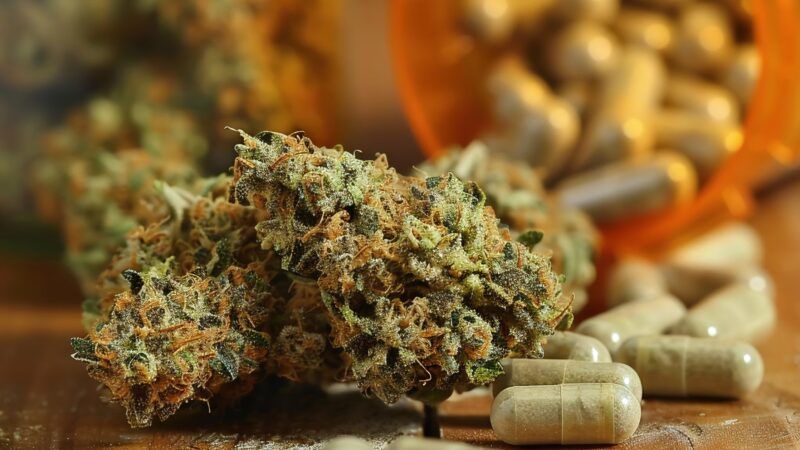Cannabis Isn't the Cure for Chronic Pain
Flawed research methods are misleading patients and might embolden prohibitionists. Marijuana has promise in treating certain sorts of discomfort, but some conditions still require powerful narcotics.

As policymakers aim to reduce opioid prescribing for the 14th year in a row, they are promoting a search for "non-addictive" pain treatment alternatives. Although medical marijuana is increasingly viewed as a leading candidate, its advocates tend to grossly exaggerate its potential to replace opioid analgesics. That hyperbole threatens the welfare of pain patients, contributes to the backlash against marijuana legalization, and could undermine other forms of drug liberalization.
A study published last July in the journal Pain epitomizes this tendency. University of Pittsburgh pain specialist Ajay D. Wasan and his colleagues present what seems to be compelling evidence of marijuana's ability to broadly treat chronic pain. Unfortunately, the study has a methodological flaw that renders its main conclusion meaningless. (For a technical discussion of this flaw, please see the letter to the editor I wrote with Chad D. Kollas and the authors' response.)
Wasan et al. used an innovative statistical technique to compare chronic pain patients who received marijuana recommendations with chronic pain patients who received standard pharmaceuticals, including opioids. They found that the marijuana patients reported significantly higher reductions in pain. But the two groups were much too different to justify any conclusions from that comparison.
Although the authors' statistical technique can often make causal comparisons between largely different groups, the method still requires minimal similarities between the populations. In this study, 432 of the 440 subjects in the marijuana group (98.1 percent) had a diagnosis for neuropathic pain—one of the few conditions marijuana is known to alleviate. By contrast, 1,203 of the 8,114 subjects in the standard-treatment group (14.8 percent) suffered from neuropathic pain.
The upshot is that just eight patients in the marijuana group were statistically weighted to represent 6,911 individuals in the standard-care group—the ones with other forms of chronic pain. In other words, 1.8 percent of the marijuana group was used to model patients without neuropathic pain, who accounted for 85.1 percent of the standard-treatment group. That selection bias fatally compromises the study's findings. Wassan et al. responded to this critique by highlighting that they used painDETECT categories to quantify neuropathic pain instead of International Classification of Diseases 10th Revision (ICD-10) codes, but as we explained in our letter with the study data, painDETECT poorly predicts neuropathic pain severity.
To illustrate our main point, consider two different groups of people with arm pain. One group is treated with hard casts, while the other gets nothing. If almost everyone in the group treated with casts had a broken arm, we'd expect that group to eventually report improved outcomes. But if the vast majority of the other group is suffering not from fractures but from burns or abrasions, we wouldn't expect casting to reliably help that group. It would be reckless to conclude, based on a comparison of those two groups, that casts should be used to heal arms that aren't broken.
Statistical malpractice is common within the medical marijuana literature. Academic advocates have long pushed marijuana to treat conditions such as anorexia, ADHD, autism, and even cancer. They used initial, low-quality research to promote state-level legalization of medical marijuana to treat these conditions across the United States. But more recent reviews reveal that marijuana's medical applications are much narrower than the wide range of conditions that can justify a doctor's recommendation under many state laws. When it comes to chronic pain, marijuana does have some promise in treating discomfort caused by neuropathy and fibromyalgia. But attempting to use it for conditions that require powerful narcotics is apt to harm patients.
The push for pain reliever substitutes comes amid continuing federal actions to artificially reduce the supply of prescription opioids through manufacturing quotas. Those restrictions have caused a shortage of opioid analgesics, leaving doctors unable to find appropriate pain medications for their patients.
Because over-the-counter medications like acetaminophen (Tylenol) and nonsteroidal anti-inflammatory drugs (NSAIDs) like aspirin and ibuprofen cause major organ damage when used for prolonged periods, the lack of an adequate opioid supply has made it difficult for doctors to find safe drugs for chronic pain. Contrary to popular belief, opioids have very few negative effects on the body when taken as directed. If a marijuana derivative could work as an all-purpose pain reliever, it might be the only reasonable opioid replacement for chronic pain. But the evidence seems to be stacked against marijuana's effectiveness at treating pain, except in limited circumstances.
Prohibitionists have long argued that there is insufficient scientific evidence to justify legalizing marijuana for medical or recreational use. Studies with glaring methodological flaws, like Wasan et al.'s, provide them with ammunition to shoot down the entire body of cannabis research. This situation is especially frustrating because there is legitimate evidence supporting marijuana's therapeutic benefits for some conditions. When advocates oversell weak studies, they risk undermining stronger evidence and sabotaging future liberalization efforts, especially for other drugs.
Prohibitionists argue that medical marijuana is a strategy aimed at achieving de facto recreational access, and they have a point. The evidence indicates that marijuana can't treat most of the conditions that justify referrals under state laws, which are often written so broadly that basically anyone who wants marijuana can gain access.
Medical marijuana advocates should demand better research. As the war on opioid prescribing continues, they should not promote inadequate substitutes to treat pain. Although cannabis derivatives do have a place in medicine, promoting marijuana as a panacea hurts patients and undermines the credibility of drug policy reformers.
Editor's Note: As of February 29, 2024, commenting privileges on reason.com posts are limited to Reason Plus subscribers. Past commenters are grandfathered in for a temporary period. Subscribe here to preserve your ability to comment. Your Reason Plus subscription also gives you an ad-free version of reason.com, along with full access to the digital edition and archives of Reason magazine. We request that comments be civil and on-topic. We do not moderate or assume any responsibility for comments, which are owned by the readers who post them. Comments do not represent the views of reason.com or Reason Foundation. We reserve the right to delete any comment and ban commenters for any reason at any time. Comments may only be edited within 5 minutes of posting. Report abuses.
Please to post comments




"Prohibitionists argue that medical marijuana is a strategy aimed at achieving de facto recreational access, and they have a point."
Maybe, but so what? End the failed War on Drugs.
Prohibitionists argue that medical marijuana is a strategy aimed at achieving de facto recreational access
Well, it was that like 20 years ago. Now that ship has sailed, I think.
My wife has chronic pain. They make it difficult to get opioid but not impossible. They are not so great in that roll. Plus a ton of bad side effects.
Cannabis is great for her because it puts her to sleep with no real side effects (she gained weight). It doesn't really cure acute pain. You forget it and in her case , go to sleep. I know another lady who uses it effectively She says that she is able to ignore it.
Not a panacea, but good medicine.
Sounds like someone is still taking that sweet Pharma money.
If it increases the wellbeing of someone who happens to be in a lot of pain isn't that still useful?
You're missing the point. By overselling the benefits using biased "science", they are handing ammunition to the unrepentant drug warriors who are just looking for an excuse to roll everything back.
The juxtaposition of this next to RFK is insane.
Make up your mind teenReason.
Victimless crime. Drugs shouldn’t be illegal.
Damnit! I just spent the last 15 years reading articles in this rag about how marijuana was literally medicine which had the potential to cure nearly anything and denying it to suffering people was a moral crisis and human tragedy.
Koch must have dumped stock in ABC and bought up some in big pharma.
Yup. This is the first (or at least most) honest critique I've read about the medical efficacy of weed from Reason. JJR should really drop out of medical school and engage with more street fair artists so he can get his facts straight.
Along several fronts this article is very "rational but very anti-Reason".
I'm pretty sure the paragraph explaining the error using the cast analogy is completely lost on the "BORDURZ ARE IMAJUNARY KONSTRUKTS"/"My mask protects you, your mask protects me." crowd.
TL;DR yet, but my retort in the meantime to the headline is, "So what? Nothing is."
I am shocked, shocked, that the medical Marijuana advocates were somewhat less than honest about the pain relief efficacy of their favorite recreational drug.
Marijuana's effectiveness for treating chronic pain is already well documented over decades of research.
From what I've heard, a lot of research has shown that opiates are good for acute pain, but somewhere between ineffective and dangerous when used to treat chronic pain. It's easy to produce data "proving" that long-term opiate patients "need" their opiates when their brains have become chemically dependent on those meds, since the detox process itself is painful, and reportedly often leads to the "hooked" brain creating a felt pain response in the absence of the meds until the detox is complete, and when the system is finally cleaned out, that kind of pain will recede or vanish once the chemical dependence is broken and the patient's brain chemistry returns to "normal" without the presence of the opiates.
When the marijuana treated group was asked to rate their pain levels after three months of marijuana treatment, their response was, "Pain? What pain? Far freakin' OUT, man!"
Just take Tylenol.
Way to tie it all together.
I can't speak to chronic pain but I have seen real life benefits from cannabis. I'm a pretty old guy and developed a nasty palsy after a severely inflamed nerve back in 2020. Coincidentally happened a few months after I got the J and J jab because I had booked a trip to Mexico and it was that or cancel. But that's another story. Anyway I was mostly flat on my back and couldn't work for six months. Went through endless testing and prescriptions and got back on my feet but when I finally got off all of the drugs the palsy persisted, to this day. It's more than an embarrassment, the simplist of tasks become a monumental project when my hands fail me. I recently started eating indica gummies with 25% THC in the morning and the palsy disappears. Not enough to really feel high but the physical effect is undeniable. Also Mrs Grimsrud suffered from insomnia for decades and finally found that a cannabis strain, Grand Daddy Purple puts her right to sleep. The therapeutic effects of cannabis are well known and well documented. Will it cure cancer? Probably not. Are opioids a better choice for severe chronic pain? Probably. Every individual needs to make their own choices. But I'd rather smoke a plant than rely on the self interested medical industry.
GG, I am glad you and Mrs. G. found something that works well for each of you. It should never be illegal.
An old eastern European cure for insomnia was to put a poppy head underneath the pillow…but might get one in trouble with the DEA.
All legal here in Illinois but a whole lot cheaper in Michigan so I'm still guilty of smuggling contraband across Indiana. That's how stupid this shit is.
Like Rittenhouse, you CrOsSeD sTaTe LiNeS!
I'm not into any drugs, but I find your take both reasoned and reasonable, and I'm glad you've found something that grants relief. Getting older and broken down is balls.
I think your experience is common, and it's why almost every state has legalized medical marijuana at this point. But to the author's point, lying about the efficacy of something only makes the real arguments for legalization slower and more difficult at best, and increases the risk of repeal in the future.
That hyperbole threatens the welfare of pain patients, contributes to the backlash against marijuana legalization, and could undermine other forms of drug liberalization.
"Pain patients."
How about we just get a medical community that asks, "Did you recently suffer major physical trauma?" before considering prescription pain relief. If the answer doesn't come with something like recent surgery or fractured bones or aggressive cancer or advanced chronic conditions (especially into late aging) - then reply, "Get some OTC pain relievers." Or "quit being a pussy and rub some dirt on it."
Also, don't let patients self-medicate prescription pain relievers. If the pain is really that bad, make it an inpatient treatment, or demand that they hoof it to the clinic so it can be administered.
We produced a much healthier and heartier society when the answer to patients whining about their "pain" (which is often just mild inconvenience) was "suck it up buttercup," instead of "let's put you into a regular drug haze."
Gets a thousand times worse when we get into the psych drugs.
I thought: "The Science was Settled" and medical pot was good. I guess some science is settled and some is not?